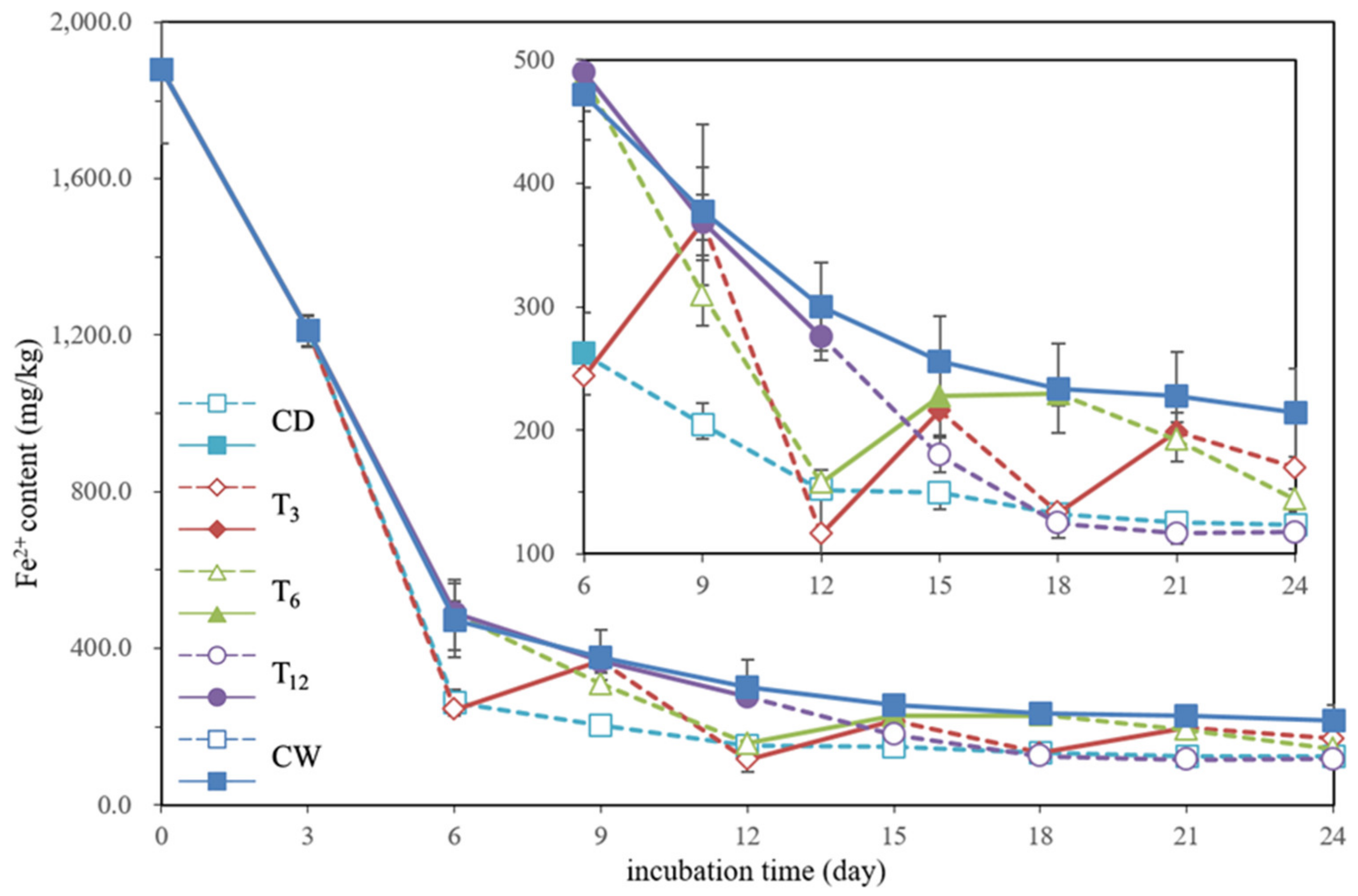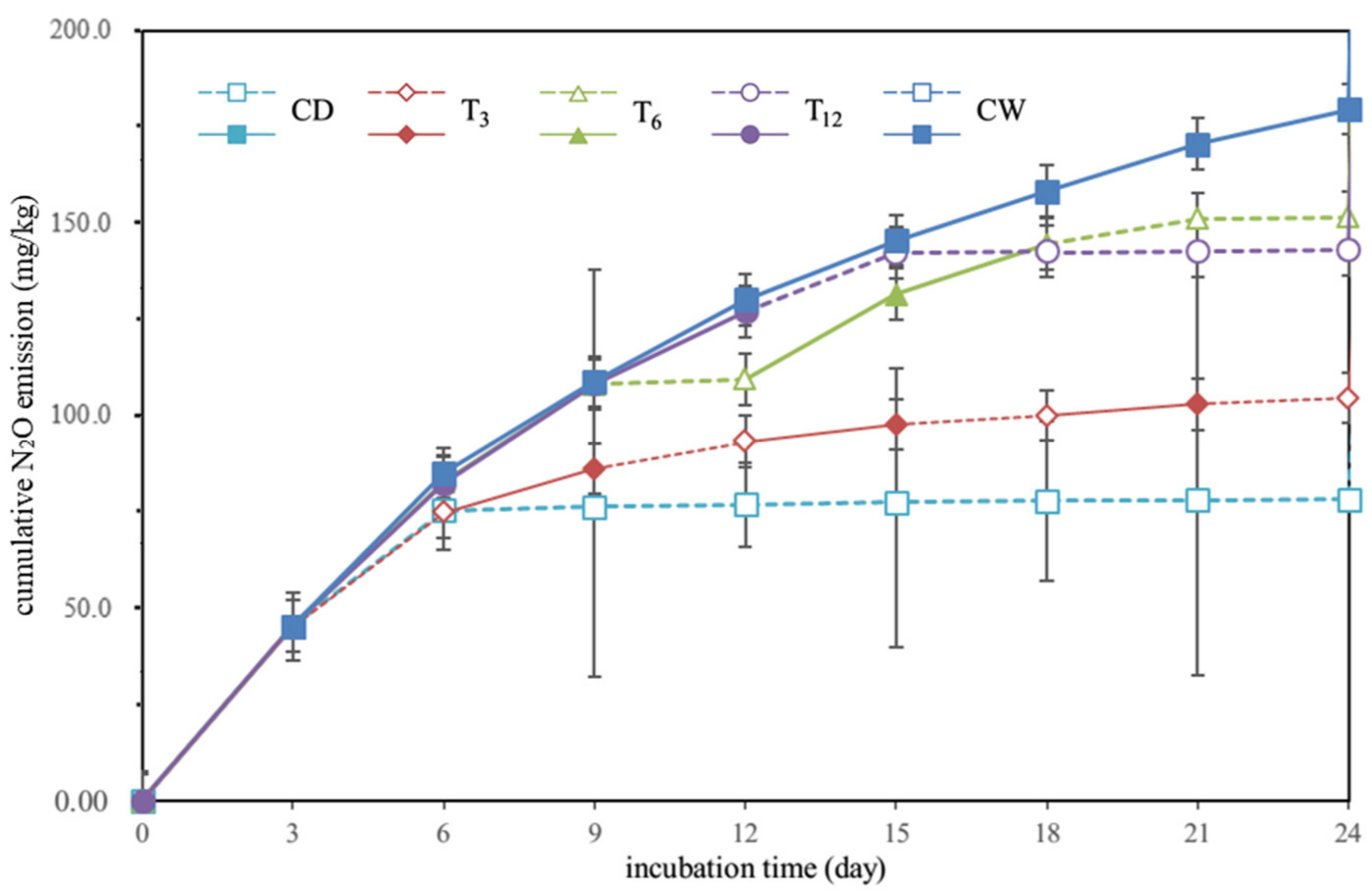Effects of Drying-Rewetting Cycles on Ferrous Iron-Involved Denitrification in Paddy Soils
Abstract
:1. Introduction
2. Materials and Methods
2.1. Soil Samples
2.2. Design of Batch Experiments
2.3. Measurements
2.4. Statistical Analyses
3. Results
3.1. Dynamics of the Soil Nitrate Nitrogen
3.2. Dynamic of the Soil Ferrous Iron Content
3.3. Dynamics of Total Organic Carbon in the Soil
4. Discussion
4.1. Nitrogen Dynamics
4.2. Fe Dynamics
5. Conclusions
Author Contributions
Funding
Institutional Review Board Statement
Informed Consent Statement
Data Availability Statement
Conflicts of Interest
References
- Ashok, V.; Hait, S. Remediation of nitrate-contaminated water by solid-phase denitrification process—A review. Environ. Sci. Pollut. Res. 2015, 22, 8075–8093. [Google Scholar] [CrossRef]
- Zhu, X.; Burger, M.; Doane, T.A.; Horwath, W.R. Ammonia oxidation pathways and nitrifier denitrification are significant sources of N2O and NO under low oxygen availability. Proc. Natl. Acad. Sci. USA 2013, 110, 6328–6333. [Google Scholar] [CrossRef] [PubMed] [Green Version]
- Liu, D.; Zhu, X.; Wang, Y. China’s agricultural green total factor productivity based on carbon emission: An analysis of evolution trend and influencing factors. J. Clean. Prod. 2021, 278, 123692. [Google Scholar] [CrossRef]
- Zhang, W.-f.; Dou, Z.-x.; He, P.; Ju, X.T.; Powlson, D.; Chadwick, D.; Norse, D.; Lu, Y.L.; Zhang, Y.; Wu, L.; et al. New technologies reduce greenhouse gas emissions from nitrogenous fertilizer in China. Proc. Natl. Acad. Sci. USA 2013, 110, 8375–8380. [Google Scholar] [CrossRef] [Green Version]
- Knowles, R. Denitrification. Microbiol. Rev. 1982, 46, 43–70. [Google Scholar] [CrossRef]
- Weber, K.A.; Achenbach, L.A.; Coates, J.D. Microorganisms pumping iron: Anaerobic microbial iron oxidation and reduction. Nat. Rev. Microbiol. 2006, 4, 752–764. [Google Scholar] [CrossRef] [Green Version]
- Dutta, T.; Carles-Brangarí, A.; Fernàndez-Garcia, D.; Rubol, S.; Tirado-Conde, J.; Sanchez-Vila, X. Vadose zone oxygen (O2) dynamics during drying and wetting cycles: An artificial recharge laboratory experiment. J. Hydrol. 2015, 527, 151–159. [Google Scholar] [CrossRef] [Green Version]
- Cho, S.; Kambey, C.; Nguyen, V. Performance of Anammox Processes for Wastewater Treatment: A Critical Review on Effects of Operational Conditions and Environmental Stresses. Water 2019, 12, 20. [Google Scholar] [CrossRef] [Green Version]
- Song, X.; Ehde, P.M.; Weisner, S.E.B. Effects of Water Depth and Phosphorus Availability on Nitrogen Removal in Agricultural Wetlands. Water 2019, 11, 2626. [Google Scholar] [CrossRef] [Green Version]
- Rivett, M.O.; Buss, S.R.; Morgan, P.; Smith, J.W.N.; Bemment, C.D. Nitrate attenuation in groundwater: A review of biogeochemical controlling processes. Water Res. 2008, 42, 4215–4232. [Google Scholar] [CrossRef]
- Zhang, M.; Zheng, P.; Li, W.; Wang, R.; Ding, S.; Abbas, G. Performance of nitrate-dependent anaerobic ferrous oxidizing (NAFO) process: A novel prospective technology for autotrophic denitrification. Bioresour. Technol. 2015, 179, 543–548. [Google Scholar] [CrossRef]
- Han, J.; Shi, L.; Wang, Y.; Chen, Z.; Xu, J. Investigation of ferrous iron-involved anaerobic denitrification in three subtropical soils of southern China. J. Soils Sediments 2018, 18, 1873–1883. [Google Scholar] [CrossRef]
- Xu, B.; Shi, L.; Zhong, H.; Wang, K. Investigation of Fe(II) and Mn(II) involved anoxic denitrification in agricultural soils with high manganese and iron contents. J. Soils Sediments 2021, 21, 452–468. [Google Scholar] [CrossRef]
- Li, X.; Zhang, W.; Liu, T.; Chen, L.; Chen, P.; Li, F. Changes in the composition and diversity of microbial communities during anaerobic nitrate reduction and Fe(II) oxidation at circumneutral pH in paddy soil. Soil Biol. Biochem. 2016, 94, 70–79. [Google Scholar] [CrossRef]
- Lovley, D.R.; Phillips, E.J.P. Novel Mode of Microbial Energy Metabolism: Organic Carbon Oxidation Coupled to Dissimilatory Reduction of Iron or Manganese. Appl. Environ. Microbiol. 1988, 54, 1472–1480. [Google Scholar] [CrossRef] [Green Version]
- Straub, K.L.; Benz, M.; Schink, B.; Widdel, F. Anaerobic, nitrate-dependent microbial oxidation of ferrous iron. Appl. Environ. Microbiol. 1996, 62, 1458–1460. [Google Scholar] [CrossRef] [Green Version]
- Tong, D.; Zhuang, J.; Chen, X. Reactive Transport and Removal of Nutrients and Pesticides in Engineered Porous Media. Water 2019, 11, 1316. [Google Scholar] [CrossRef] [Green Version]
- Melton, E.D.; Swanner, E.D.; Behrens, S.; Schmidt, C.; Kappler, A. The interplay of microbially mediated and abiotic reactions in the biogeochemical Fe cycle. Nat. Rev. Microbiol. 2014, 12, 797–808. [Google Scholar] [CrossRef]
- Mejia, J.; Roden, E.E.; Ginder-Vogel, M. Influence of Oxygen and Nitrate on Fe (Hydr)oxide Mineral Transformation and Soil Microbial Communities during Redox Cycling. Environ. Sci. Technol. 2016, 50, 3580–3588. [Google Scholar] [CrossRef] [Green Version]
- Baeseman, J.L.; Smith, R.L.; Silverstein, J. Denitrification potential in stream sediments impacted by acid mine drainage: Effects of pH, various electron donors, and iron. Microb. Ecol. 2006, 51, 232–241. [Google Scholar] [CrossRef]
- Schimel, J.; Balser, T.C.; Wallenstein, M. Microbial stress-response physiology and its implications for ecosystem function. Ecology 2007, 88, 1386–1394. [Google Scholar] [CrossRef]
- Cui, Y.; Huang, J. A Review of Researches on Efficient Agricultural Water Use in China. Bull. Chin. Acad. Sci. 2012, 26, 48–53. [Google Scholar]
- Yemadje, P.L.; Chevallier, T.; Guibert, H.; Bertrand, I.; Bernoux, M. Wetting-drying cycles do not increase organic carbon and nitrogen mineralization in soils with straw amendment. Geoderma 2016, 304, 68–75. [Google Scholar] [CrossRef]
- De Nijs, E.A.; Hicks, L.C.; Leizeaga, A.; Tietema, A.; Rousk, J. Soil microbial moisture dependences and responses to drying–rewetting: The legacy of 18 years drought. Glob. Chang. Biol. 2019, 25, 1005–1015. [Google Scholar] [CrossRef]
- Stutter, M.; Graeber, D.; Weigelhofer, G. Available Dissolved Organic Carbon Alters Uptake and Recycling of Phosphorus and Nitrogen from River Sediments. Water 2020, 12, 3321. [Google Scholar] [CrossRef]
- Borken, W.; Matzner, E. Reappraisal of drying and wetting effects on C and N mineralization and fluxes in soils. Glob. Chang. Biol. 2009, 15, 808–824. [Google Scholar] [CrossRef]
- Guo, X.; Drury, C.F.; Yang, X.; Daniel Reynolds, W.; Fan, R. The Extent of Soil Drying and Rewetting Affects Nitrous Oxide Emissions, Denitrification, and Nitrogen Mineralization. Soil Sci. Soc. Am. J. 2014, 78, 194. [Google Scholar] [CrossRef]
- Ma, R.; Cai, C.; Li, Z.; Wang, J.; Xiao, T.; Peng, G.; Yang, W. Evaluation of soil aggregate microstructure and stability under wetting and drying cycles in two Ultisols using synchrotron-based X-ray micro-computed tomography. Soil Tillage Res. 2015, 149, 1–11. [Google Scholar] [CrossRef]
- Fierer, N.; Schimel, J.P. Effects of drying–rewetting frequency on soil carbon and nitrogen transformations. Soil Biol. Biochem. 2002, 34, 777–787. [Google Scholar] [CrossRef]
- Li, Z.; Wu, L.; Zhang, H.; Luo, Y.; Christie, P. Effects of soil drying and wetting-drying cycles on the availability of heavy metals and their relationship to dissolved organic matter. J. Soils Sediments 2015, 15, 1510–1519. [Google Scholar] [CrossRef] [Green Version]
- Shi, A.; Yan, N.; Marschner, P. Cumulative respiration in two drying and rewetting cycles depends on the number and distribution of moist days. Geoderma 2015, 243–244, 168–174. [Google Scholar] [CrossRef]
- Cai, Z.; Shan, Y.; Xu, H. Effects of nitrogen fertilization on CH4 emissions from rice fields. Soil Sci. Plant Nutr. 2007, 53, 353–361. [Google Scholar] [CrossRef]
- Harrison-Kirk, T.; Beare, M.H.; Meenken, E.D.; Condron, L.M. Soil organic matter and texture affect responses to dry/wet cycles: Effects on carbon dioxide and nitrous oxide emissions. Soil Biol. Biochem. 2013, 57, 43–55. [Google Scholar] [CrossRef]
- Chen, M.; Liu, C.; Li, X.; Huang, W.; Li, F. Iron Reduction Coupled to Reductive Dechlorination in Red Soil. Soil Sci. 2014, 179, 457–467. [Google Scholar] [CrossRef]
- Ministry of Agriculture of the People’s Republic of China. Soil Testing—Cutting Ring Method for Determination of Field Water-Holding Capacity in Soil; NY/T 1121; Ministry of Agriculture of the People’s Republic of China: Beijing, China, 2010.
- Ministry of Environ-mental Protection of the People’s Republic of China. Soil-Determination of pH-Potentiometry; HJ 962; Ministry of Environ-mental Protection of the People’s Republic of China: Beijing, China, 2018.
- Ministry of Environmental Protection of the People’s Republic of China. Determination of Organic Matter-Ignition Loss Method; HJ 761; Ministry of Environmental Protection of the People’s Republic of China: Beijing, China, 2015.
- Ministry of Environmental Protection of the People’s Republic of China. Soil—Determination of Ammonium, Nitrite and Nitrate by Extraction with Potassium Chloride Solution-Spectrophotometric Methods; HJ 634; Ministry of Environmental Protection of the People’s Republic of China: Beijing, China, 2012.
- Ministry of Environmental Protection of the People’s Republic of China. Water Quality—Determination of Iron—Phenanthroline Spectro-Photometry; HJ/T 345; Ministry of Environmental Protection of the People’s Republic of China: Beijing, China, 2007.
- Fierer, N.; Schimel, J.P.; Holden, P.A. Variations in microbial community composition through two soil depth profiles. Soil Biol. Biochem. 2003, 35, 167–176. [Google Scholar] [CrossRef]
- Van Gestel, M.; Merckx, R.; Vlassak, K. Microbial biomass responses to soil drying and rewetting: The fate of fast- and slow-growing microorganisms in soils from different climates. Soil Biol. Biochem. 1993, 25, 109–123. [Google Scholar] [CrossRef]
- Morillas, L.; Durán, J.; Rodríguez, A.; Roales, J.; Gallardo, A.; Lovett, G.M.; Groffman, P.M. Nitrogen supply modulates the effect of changes in drying-rewetting frequency on soil C and N cycling and greenhouse gas exchange. Glob. Chang. Biol. 2015, 21, 3854–3863. [Google Scholar] [CrossRef]
- Zhang, J.; Müller, C.; Cai, Z. Heterotrophic nitrification of organic N and its contribution to nitrous oxide emissions in soils. Soil Biol. Biochem. 2015, 84, 199–209. [Google Scholar] [CrossRef]
- Lovley, D.R.; Coates, J.D. Novel forms of anaerobic respiration of environmental relevance. Curr. Opin. Microbiol. 2000, 3, 252–256. [Google Scholar] [CrossRef]
- Lovley, D.R.; Holmes, D.E.; Nevin, K.P. Dissimilatory Fe(III) and Mn(IV) Reduction. Adv. Microb. Physiol. 2004, 49, 219–286. [Google Scholar]








| Soil Site | pH | TN | TOC | NO3−-N | NH4+-N | Fe3+ | Fe2+ | Sand | Silt | Clay |
|---|---|---|---|---|---|---|---|---|---|---|
| g/kg | g/kg | mg/kg | mg/kg | g/kg | g/kg | % | % | % | ||
| De’an | 5.70 ± 0.01 | 2.23 ± 0.39 | 12.47 ± 0.20 | 1.15 ± 0.03 | 4.61 ± 0.26 | 2.03 ± 0.16 | 0.23 ± 0.01 | 26.74 ± 0.10 | 44.76 ± 0.36 | 28.50 ± 0.10 |
| NO3−-N | Fe2+ | Fe3+ | TOC | NH4+-N | N2O | |
|---|---|---|---|---|---|---|
| NO3−-N | 1 | |||||
| Fe2+ | 0.661 ** | 1 | ||||
| Fe3+ | −0.533 ** | −0.517 * | 1 | |||
| TOC | 0.943 ** | 0.721 ** | −0.555 ** | 1 | ||
| NH4+-N | −0.709 ** | −0.864 ** | −0.609 ** | −0.833 ** | 1 | |
| N2O | −0.967 ** | −0.550 ** | −0.385 ** | −0.900 ** | 0.611 ** | 1 |
Publisher’s Note: MDPI stays neutral with regard to jurisdictional claims in published maps and institutional affiliations. |
© 2021 by the authors. Licensee MDPI, Basel, Switzerland. This article is an open access article distributed under the terms and conditions of the Creative Commons Attribution (CC BY) license (https://creativecommons.org/licenses/by/4.0/).
Share and Cite
Zhang, Y.; Xu, B.; Han, J.; Shi, L. Effects of Drying-Rewetting Cycles on Ferrous Iron-Involved Denitrification in Paddy Soils. Water 2021, 13, 3212. https://doi.org/10.3390/w13223212
Zhang Y, Xu B, Han J, Shi L. Effects of Drying-Rewetting Cycles on Ferrous Iron-Involved Denitrification in Paddy Soils. Water. 2021; 13(22):3212. https://doi.org/10.3390/w13223212
Chicago/Turabian StyleZhang, Yushuai, Baokun Xu, Jiangpei Han, and Liangsheng Shi. 2021. "Effects of Drying-Rewetting Cycles on Ferrous Iron-Involved Denitrification in Paddy Soils" Water 13, no. 22: 3212. https://doi.org/10.3390/w13223212
APA StyleZhang, Y., Xu, B., Han, J., & Shi, L. (2021). Effects of Drying-Rewetting Cycles on Ferrous Iron-Involved Denitrification in Paddy Soils. Water, 13(22), 3212. https://doi.org/10.3390/w13223212






